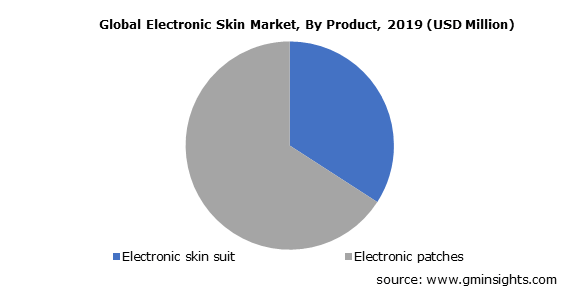Global Electronic Skin Market to cross $16bn by 2026
Published Date: March 2020
Electronic Skin Market size is set to exceed USD 16 billion by 2026, according to a new research report by Global Market Insights Inc.
The introduction of novel products owing to the recent technological advancements in robotics technology will significantly boost the market expansion. Electronic skin devices are utilized majorly for health monitoring in individuals suffering from varied ailments.
Introduction of electronic skin suit for monitoring vital signs is expected to propel the market growth
Electronic skin suits have aided in supplementing the growth of the electronic skin market owing to the varied advantages the products offer. For instance, Hexoskin was introduced in 2013 with health monitoring properties for disorders such as respiratory, cardiac, sleep and activity tracker among others. The Hexoskin is supported with mobile phone applications in iPhones.
Additionally, Hexoskin can be further customized as per an individual’s need due to the availability of developer kits. Thus, owing to the aforementioned benefits, the market is expected to garner a healthy growth rate during the forecast period.
Increased adoption of stretchable circuits will boost the electronic skin market demand
Stretchable circuits are majorly utilized in wearable electronics due to its stretchable properties, thus accounted for a significant market share in the industry. Also, stretchable circuits are available at low cost and has self-healing properties. These circuits if broken, can be healed at room temperature, which further boosts the demand of the components used.

Get more details on this report - Request Free Sample PDF
Rapid implementation of chemical sensors in wearable devices will spur the demand of electronic skin products
Chemical sensors held a substantial electronic skin market revenue in 2019 and is estimated to witness a 15.15% CAGR during the forecast years. The major share is attributed to the advantages offered by chemical sensors such as low cost of manufacturing, better linearity or response time, measurement range, sensitivity and selectivity. Also, the simple design and the possibility to minimize the size of the chemical sensors will further result in increased adoption of novel electronic skin patches.
Browse key industry insights spread across 180 pages with 378 market data tables & 12 figures & charts from the report, Electronic Skin Market Size By Product (Electronic Skin Suit, Electronic Patches), By Component (Stretchable Circuits, Photovoltaics System, Stretchable Conductors, Electro-Active Polymers), By Sensor Type (Tactile Sensors, Chemical Sensors, Electrophysiological Sensors), By Application (Health Monitoring Systems, Drug Delivery Systems, Cosmetics), By Distribution Channel (B2B {Hospitals, Cosmetic Companies, Wearable Device Manufacturers, Research Institutes}, B2C), Industry Analysis Report, Regional Outlook, Application Potential, Competitive Market Share & Forecast, 2020– 2026” in detail along with the table of contents: https://www.gminsights.com/industry-analysis/electronic-skin-market
The increasing need to avoid painful drug delivery procedures will spur the demand for drug delivery systems segment
Drug delivery systems held over 22% market share in 2019 and will witness a significant growth over the analysis timeframe. Advantages offered by new drug delivery systems in electronic skin include improving therapy by increasing the period of action and minimizing the side effects. Additionally, targeting drugs to specific sites, minimizing the doses as well as convenient route of administration will further propel the electronic skin market growth.
Business to consumer (B2C) segment is expected to grow with a healthy CAGR
B2C segment is expected to garner a higher growth during the analysis period. This is due to the increased awareness among the general population especially in the developed economies regarding the potential health benefits of using electronic skin suits and electronic skin patches. The increased awareness has resulted in the rapid adoption of skin patches globally for the purpose of health monitoring, thereby augmenting the market growth.
Upsurge in the utilization of wearable sensors especially in China to fight corona virus (COVID-19) is expected to create lucrative market in the Asia Pacific region
The Asia Pacific electronic skin market was valued at USD 1,266.8 million in 2019 and will witness a lucrative growth over the forecast period. The growth can be attributed to the presence of various wearable sensor manufacturing companies in the Asia Pacific region especially in Japan and China. Also, the recent outbreak of coronavirus pandemic has resulted in the rapid adoption of wearable sensors for continuous health monitoring of patients who were tested positive.
Further, India and China are known as the diabetes hub of world due to the presence of large patient pool. For instance, as of 2019 there are around 72.96 million adult cases of diabetes in India, whereas China has about 120 million individuals suffering from diabetes. These factors will hugely impact the market growth, creating numerous opportunities in the Asia Pacific region.
Companies are focusing launching novel technologically advanced products to expand its customer base and operations
Some of the key electronic skin market players include MC10, Xsensio, Rotex Inc., Renew Health Limited (Intelesens ltd.), Xenoma Inc. and VivaLnK, Inc. among others. These market players are focusing on launching technologically advanced products in the market with low cost prices so that customers can directly buy with the fear of reimbursement.
For instance, Xenoma’s skin suit is expected to be made available in the market in April 2020 with a price tag of around USD 30,000. However, the company started a kickstarter campaign in which the company had offered the product for less than USS 499. Thus, such campaigns and launch of novel products will propel the market growth.





